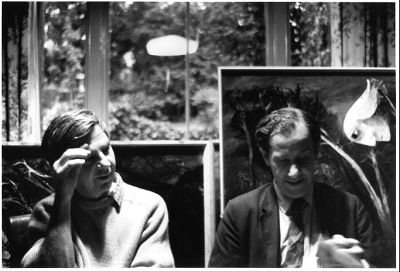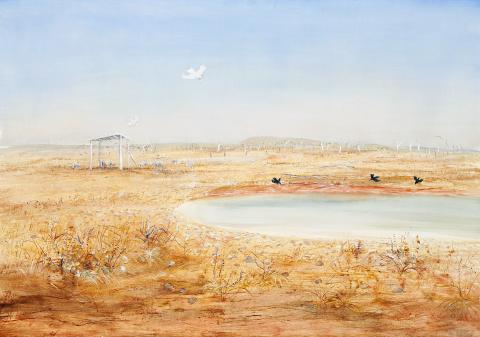WIMMERA LANDSCAPE WITH COCKATOOS, c.1965
ARTHUR BOYD
tempera and oil on composition board
86.0 x 122.0 cm
signed lower right: Arthur Boyd
bears inscription verso: CHAIRMAN’S / ROOM
possibly: Bonython Galleries, Adelaide
Energy Australia, Sydney
Sotheby’s, Sydney, 22 April 2008, lot 23
Gould collection, Melbourne
possibly: Recent Paintings from London by Arthur Boyd, Bonython Galleries, Adelaide, 28 August – 15 September 1966, cat. 2 (as ‘Landscape with Grey Lake’)
The Director’s Choice 2009, Gould Galleries, Melbourne, 7 May – 13 June 2009, cat. 1 (illus. on cover exhibition catalogue, as ‘Wimmera Landscape’)
The Director’s Choice 2015, Celebrating 35 Years, Gould Galleries, Melbourne, 1 May – 13 June 2015, cat. 12 (illus. in exhibition catalogue, as ‘Wimmera Landscape’)
possibly: Philipp, F., Arthur Boyd, Thames and Hudson, London, 1967, cat. no. 17:40, p.277 (as ‘Landscape with Grey Lake’, Collection of the Artist)
13. Arthur Boyd & Sidney Nolan, c1960.png

The last time I caught up with Arthur Boyd was at Max Harris’ funeral in Melbourne in 1995. He sat in the back seat of my car with his ex-brother-in-law John Perceval. As fellow painters their history dated over fifty years, yet they had not communicated in nearly half that time. Neither knew where to start, so they didn’t, they embraced, then sat in total silence holding hands for what seemed an eternity recalling memories of the good times and what was lost. ROB GOULD
Even today the wheat fields of the Wimmera shimmer under a crystalline Australian sky. At midday in summer, there is an overwhelming sense of somnambulism as sheep cluster around scrappy patches of shade, distant tractors trundle past, and cockatoos wheel through the air, their harsh cries shredding the silence. In Arthur Boyd’s meticulously recorded Wimmera Landscape with Cockatoos, c.1965 the artist captures the very essence of the scene and reminds us of his absolute mastery of landscape painting. By the mid-1960s, when this image was painted, Boyd was firmly established in London as an artist of note. Since arriving with his family in late 1959, he had held an acclaimed solo exhibition at the prestigious Zwemmer Gallery and been the subject of an extensive retrospective at the Whitechapel Gallery. Every Australian state gallery held examples of his work, private collectors included royalty and celebrities, and he had also successfully extended his talents into theatre and ballet.
Whilst the works that initially established him in Britain were the powerful images of his celebrated ‘Bride’ series, Boyd was also recognised as one of the most astute and sustained chroniclers of the Australian landscape, in particular the far western corner of Victoria, a vast region known as the Wimmera centred around the towns of Horsham, Ararat and Nhill. Boyd first visited during the summer of 1948–49, painting landscapes at the border of the Wimmera River and returned several times over next few years. It was these haunting yet intensely observed visions which secured his position as co-exhibitor (with the late Arthur Streeton) at the Venice Biennale of 1958. In his depictions of the Wimmera, Boyd was acknowledging the path of previous non-indigenous painters who had recorded the harsher inland regions of this country, including his old friend Sidney Nolan.1 The difference with Boyd’s depictions was that whilst the Wimmera is relatively distant, it was then still an area with familial connections to many urban-based Australians. City families often had land-based cousins so that even though they may never have actually visited their relations, people still felt a visceral connection to the region. That association continued for Boyd even after he established himself in London, noting that he invariably felt ‘nostalgic for prickly grass.’2
Utilising the translucent tempera and glaze technique he had mastered in the original Wimmera series, Wimmera Landscape with Cockatoos has its surface punctuated further by expressive marks of low impasto as if Boyd is emphasising particular points in the landscape, re-animating his memory of place. Note the fidelity of the spiky grasses and thistles in the foreground, the whitened trunks of ring-barked trees and beyond, the low rise of the Grampian hills. It is a truly palpable rendition of the artist’s beloved homeland. As if to accentuate its force of personal connection, Energy Australia, who previously owned the painting, clearly determined its destination for display, namely their Chairman’s own office where it would have marked a clear statement of intent as to that company’s respect for rural Australia.3 Wimmera Landscape with Cockatoos is a fascinating, stilled point in time, a mesmerising image by an Australian icon at the height of his painterly powers.
1. Nolan also painted scenes of the Wimmera whilst based there with the army between 1942 and 1944.
2. Nial, B., The Boyds, Melbourne University Press, Victoria, 2007 (revised edition), p. 336
3. The text ‘Chairman’s Office’ is inscribed in chalk verso.
ANDREW GAYNOR
